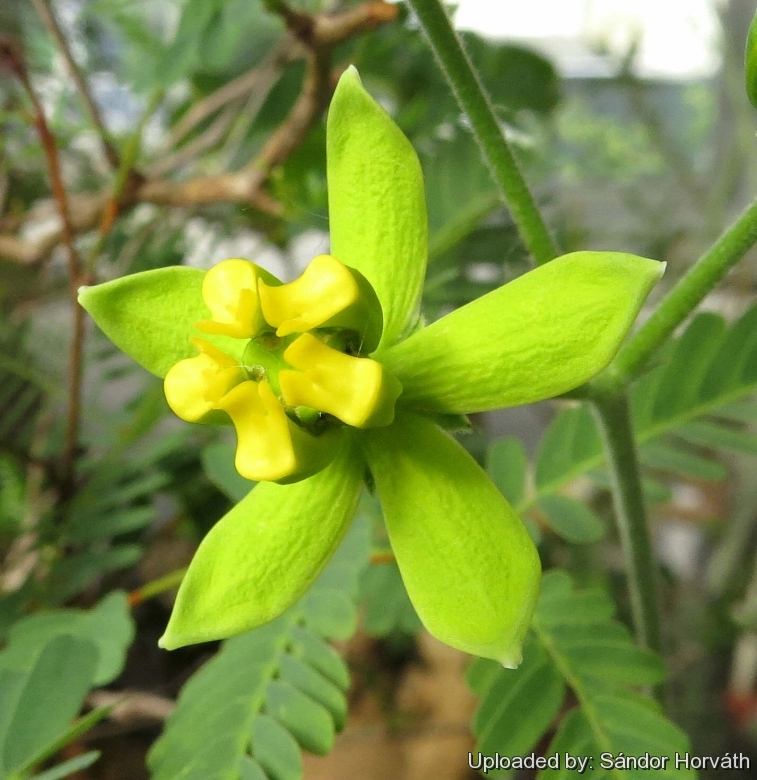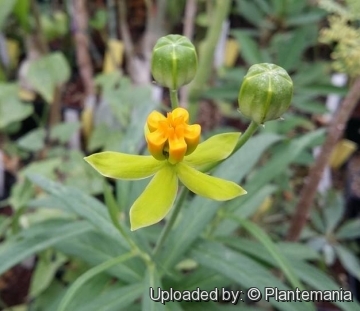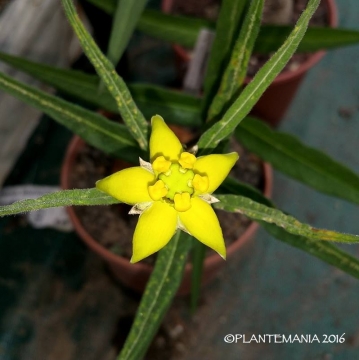
Stathmostelma fornicatum Photo by: Sándor Horváth
Origin and Habitat: Stathmostelma fornicatumSN|31722]]SN|31722]] (ssp. fornicatum) occurs in Zambia (Northern, Eastern, Central, Lusaka, Southern and and Western Provinces), Southern Tanzania, Malawi, Mozambique; also rare and local in Western Zimbabwe at Victoria Falls .
Altitude range: Approx 900 meters above sea level
Habitat and ecology: This species grows in seasonally waterlogged grassy areas in mopane or Acacia woodland, dambos and floodplains. Flowers seen mainly in the first few months of the rainy season.
Synonyms:
See all synonyms of Stathmostelma fornicatum
Description: Stathmostelma fornicatumSN|31722]]SN|31722]] is a perennial herb with annual stems arising from stout, perennial, subterranean root tubers (geophytic). The flowers are bright yellow with a slight greenish tinge. The leaves and stems contain milky latex.
Stems: Annual stems single, branching near the base, up to 60 cm tall, ascending or erect, apically curved, hairless or weakly pubescent with short white hairs, with milky latex;
Leaves: Petiolate, opposite, lamina 8-20 cm x 3 -13 mm, linear, acute, sometimes weakly pubescent with stiff white hairs, particularly on the margin and the midrib..
Inflorescences: Terminal or extra-axillary (2-)3-4(-5) flowered umbels on a peduncle 5-18 cm long. Pededicels 3-4 cm long.
Flowers: Sepals 5-6 mm long, 3 mm wide, glabrous. Corolla flat to bowl-shaped, corolla-lobes spreading, 14-20 mm long, 4-8 mm wide, oblong-elliptic, more or less acute, greenish and hairless on the outside, chrome-yellow and minutely papillose inside. Corona lobes yellow or orange, 7 mm long (c. 1.5 times as tall as the column), erect, outside bulging and keeled, lower margin extending with a tooth over the column, inside delicately papillose; 1 or 2 small teeth are present in the cavity of the corona lobes. Pollinia oblong, around 1.1 x 0.35 mm.
Fruits : The fruit are single fusiform capsules (follicles) with the tightly packed seeds inside up to 11 cm long, and 0.6 cm in diameter, beaked, smooth, hairless when mature, erect on a straight pedicel.
Seeds: 5 x 3 mm, ovate.
Subspecies, varieties, forms and cultivars of plants belonging to the Stathmostelma fornicatum group
 Stathmostelma fornicatum (N.E.Br.) Bullock: is a perennial herb with annual stems arising from a perennial root tuber. Flowers yellow with 1 or 2 small teeth in the cavity of the corona lobes. Distribution: Zambia, Tanzania, Malawi, Mozambique and Zimbabwe.
Stathmostelma fornicatum (N.E.Br.) Bullock: is a perennial herb with annual stems arising from a perennial root tuber. Flowers yellow with 1 or 2 small teeth in the cavity of the corona lobes. Distribution: Zambia, Tanzania, Malawi, Mozambique and Zimbabwe.  Stathmostelma fornicatum subs. tridentatum Goyder: differs from ssp. fornicatum for having 2 mm long tooth-like inner appendage in corona lobes. Distribution: Tanzania.
Stathmostelma fornicatum subs. tridentatum Goyder: differs from ssp. fornicatum for having 2 mm long tooth-like inner appendage in corona lobes. Distribution: Tanzania.
Bibliography: Major references and further lectures
1) Focke Albers, Ulrich Meve “Illustrated Handbook of Succulent Plants: Asclepiadaceae: Asclepiadaceae” Volume 4 Springer Science & Business Media, 2002
2) Doreen Bolnick “A Guide to the Common Wild Flowers of Zambia and Neighbouring Regions” Macmillan, 1995
3) Hyde, M.A., Wursten, B.T., Ballings, P. & Coates Palgrave, M. (2015). Flora of Zimbabwe: Species information: Stathmostelma fornicatum subsp. fornicatum.
http://www.zimbabweflora.co.zw/speciesdata/species.php?species_id=145930, retrieved 15 August 2015
4) Goyder, D.J. (1998). "A revision of the African genus Stathmostelma K. Schum." Kew Bulletin 53 Pages 592 - 593.
 Stathmostelma fornicatum Photo by: © Plantemania
Stathmostelma fornicatum Photo by: © Plantemania Stathmostelma fornicatum Photo by: © Plantemania
Stathmostelma fornicatum Photo by: © PlantemaniaCultivation and Propagation: Stathmostelma fornicatumSN|31722]]SN|31722]] is an interesting addition to a collection, but rarely seen in cultivation.
Growth rate: It grows well, though very slowly, but it possible to increase the speed of growth to some extent by providing adequate amount of water, warmth, and fertilizer during the active growing season, but it’s susceptible to rotting if too wet.
Exposure: It needs light shade, but the caudex should be in the shade, while the leaves prefer some sun. Avoid direct blasting sun in summer. Bright light if grown indoors.
Soil: In pots it needs a very porous potting medium (add pumice, vulcanite, and perlite). It does better in a rather acidic soil.
Waterings: Water frequently while plant is in full growth, but keep dry during the winter after the branches have died back. It rot easily and do NOT like a lot of water when it has no leaves.
Fertilizer: Benefits from moderate doses of a well-balanced, slow-release fertilizer.
Frost tolerance: Due to its African origin keep warm in winter, the minimum safe average temperature is 15°C, although it can go lower for short periods. It can be grown outdoors in frost-free climates, need anyway to kept above 10°C and dry in winter. It is very prone to rot in cool, wet conditions. USDA Zone 10-12, but does very well in containers.
Maintenance: Repot every two years. It like pots with generous drain holes. In the winter, the branches die back and should be cut back to encourage branching, to maintain an attractive shape and to ensure caudex habit.
Propagation: The species can be propagated by seeds (and cuttings ? too). The plants for decoration are grown from seed since they develop a caudex.












